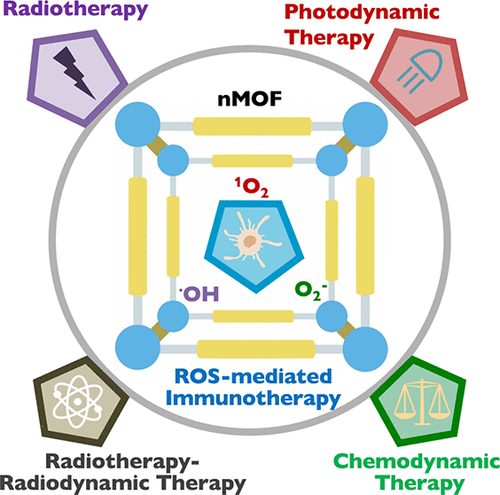当前位置:
X-MOL 学术
›
ACS Cent. Sci.
›
论文详情
Our official English website, www.x-mol.net, welcomes your feedback! (Note: you will need to create a separate account there.)
Nanoscale Metal-Organic Frameworks Generate Reactive Oxygen Species for Cancer Therapy.
ACS Central Science ( IF 18.2 ) Pub Date : 2020-05-15 , DOI: 10.1021/acscentsci.0c00397 Kaiyuan Ni 1 , Guangxu Lan 1 , Wenbin Lin 1
ACS Central Science ( IF 18.2 ) Pub Date : 2020-05-15 , DOI: 10.1021/acscentsci.0c00397 Kaiyuan Ni 1 , Guangxu Lan 1 , Wenbin Lin 1
Affiliation

|
In the past 15 years, enormous progress has been made in cancer nanotechnology, and a several nanoparticles have entered clinical testing for cancer treatment. Among these nanoparticles are nanoscale metal–organic frameworks (nMOFs), a class of organic–inorganic hybrid nanomaterials constructed from metal binding sites and bridging ligands, which have attracted significant attention for their ability to integrate porosity, crystallinity, compositional and structural tunability, multifunctionality, and biocompatibility into a singular nanomaterial for cancer therapies. This Outlook article summarizes the progress on the design of nMOFs as nanosensitizers for photodynamic therapy (PDT), radiotherapy (RT), radiotherapy–radiodynamic therapy (RT-RDT), and chemodynamic therapy (CDT) via nMOF-mediated reactive oxygen species (ROS) generated under external energy stimuli or in the presence of endogenous chemical triggers. Inflammatory responses induced by nMOF-mediated ROS generation activate tumor microenvironments to potentiate cancer immunotherapy, extending the local treatment effects of nMOF-based ROS therapy to distant tumors via abscopal effects. Future research directions in nMOF-mediated ROS therapies and the prospect of clinical applications of nMOFs as cancer therapeutics are also discussed.
中文翻译:

纳米级金属有机框架产生用于癌症治疗的活性氧。
在过去的 15 年中,癌症纳米技术取得了巨大的进步,一些纳米粒子已进入癌症治疗的临床试验。在这些纳米颗粒中,有纳米级金属-有机框架(nMOFs),这是一类由金属结合位点和桥接配体构成的有机-无机杂化纳米材料,因其集成孔隙率、结晶度、组成和结构可调性、多功能性的能力而备受关注。 ,并将生物相容性转化为用于癌症治疗的单一纳米材料。这篇展望文章总结了 nMOFs 作为光动力疗法 (PDT)、放射疗法 (RT)、放射疗法-放射动力疗法 (RT-RDT) 的纳米增敏剂的设计进展,通过在外部能量刺激或存在内源性化学触发物的情况下产生的 nMOF 介导的活性氧 (ROS) 进行化学动力学治疗 (CDT)。nMOF 介导的 ROS 生成诱导的炎症反应激活肿瘤微环境以增强癌症免疫治疗,通过异位效应将基于 nMOF 的 ROS 治疗的局部治疗效果扩展到远处肿瘤。还讨论了 nMOF 介导的 ROS 治疗的未来研究方向以及 nMOF 作为癌症治疗的临床应用前景。通过远隔效应将基于 nMOF 的 ROS 治疗的局部治疗效果扩展到远处肿瘤。还讨论了 nMOF 介导的 ROS 治疗的未来研究方向以及 nMOF 作为癌症治疗的临床应用前景。通过远隔效应将基于 nMOF 的 ROS 治疗的局部治疗效果扩展到远处肿瘤。还讨论了 nMOF 介导的 ROS 治疗的未来研究方向以及 nMOF 作为癌症治疗的临床应用前景。
更新日期:2020-06-24
中文翻译:

纳米级金属有机框架产生用于癌症治疗的活性氧。
在过去的 15 年中,癌症纳米技术取得了巨大的进步,一些纳米粒子已进入癌症治疗的临床试验。在这些纳米颗粒中,有纳米级金属-有机框架(nMOFs),这是一类由金属结合位点和桥接配体构成的有机-无机杂化纳米材料,因其集成孔隙率、结晶度、组成和结构可调性、多功能性的能力而备受关注。 ,并将生物相容性转化为用于癌症治疗的单一纳米材料。这篇展望文章总结了 nMOFs 作为光动力疗法 (PDT)、放射疗法 (RT)、放射疗法-放射动力疗法 (RT-RDT) 的纳米增敏剂的设计进展,通过在外部能量刺激或存在内源性化学触发物的情况下产生的 nMOF 介导的活性氧 (ROS) 进行化学动力学治疗 (CDT)。nMOF 介导的 ROS 生成诱导的炎症反应激活肿瘤微环境以增强癌症免疫治疗,通过异位效应将基于 nMOF 的 ROS 治疗的局部治疗效果扩展到远处肿瘤。还讨论了 nMOF 介导的 ROS 治疗的未来研究方向以及 nMOF 作为癌症治疗的临床应用前景。通过远隔效应将基于 nMOF 的 ROS 治疗的局部治疗效果扩展到远处肿瘤。还讨论了 nMOF 介导的 ROS 治疗的未来研究方向以及 nMOF 作为癌症治疗的临床应用前景。通过远隔效应将基于 nMOF 的 ROS 治疗的局部治疗效果扩展到远处肿瘤。还讨论了 nMOF 介导的 ROS 治疗的未来研究方向以及 nMOF 作为癌症治疗的临床应用前景。


























 京公网安备 11010802027423号
京公网安备 11010802027423号